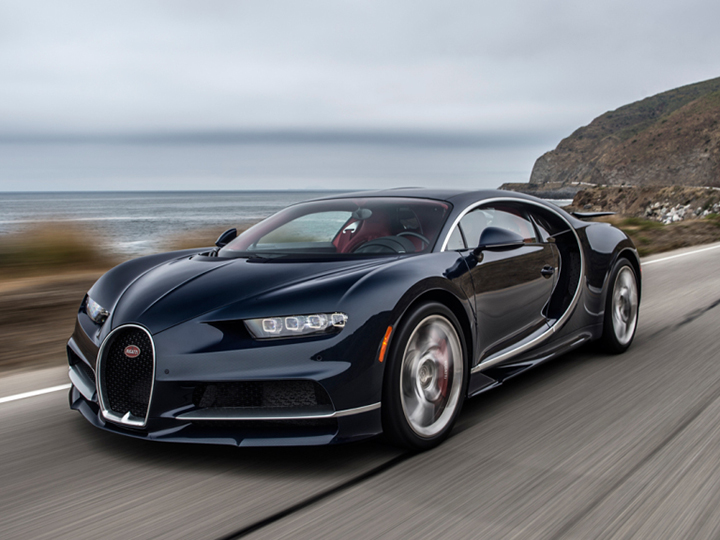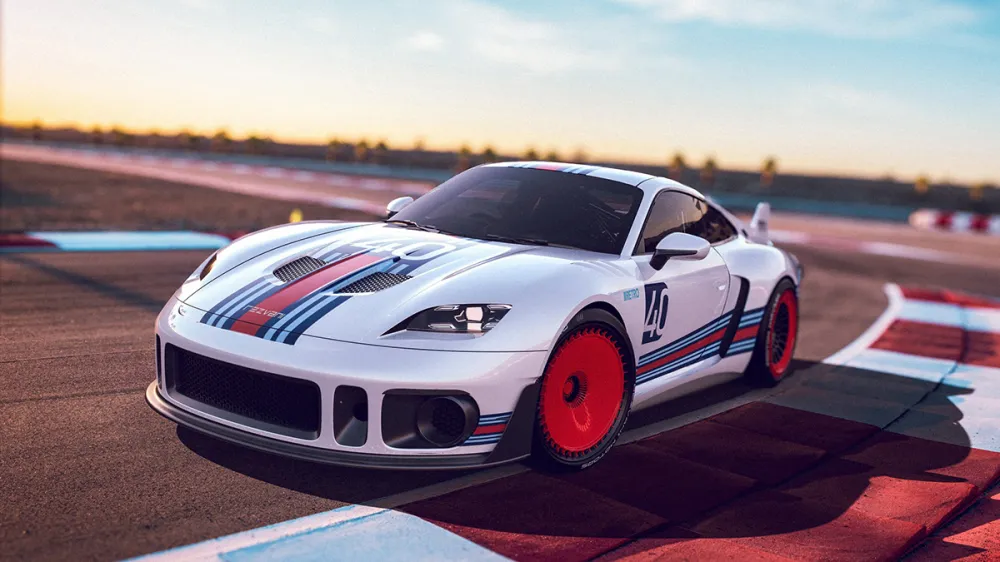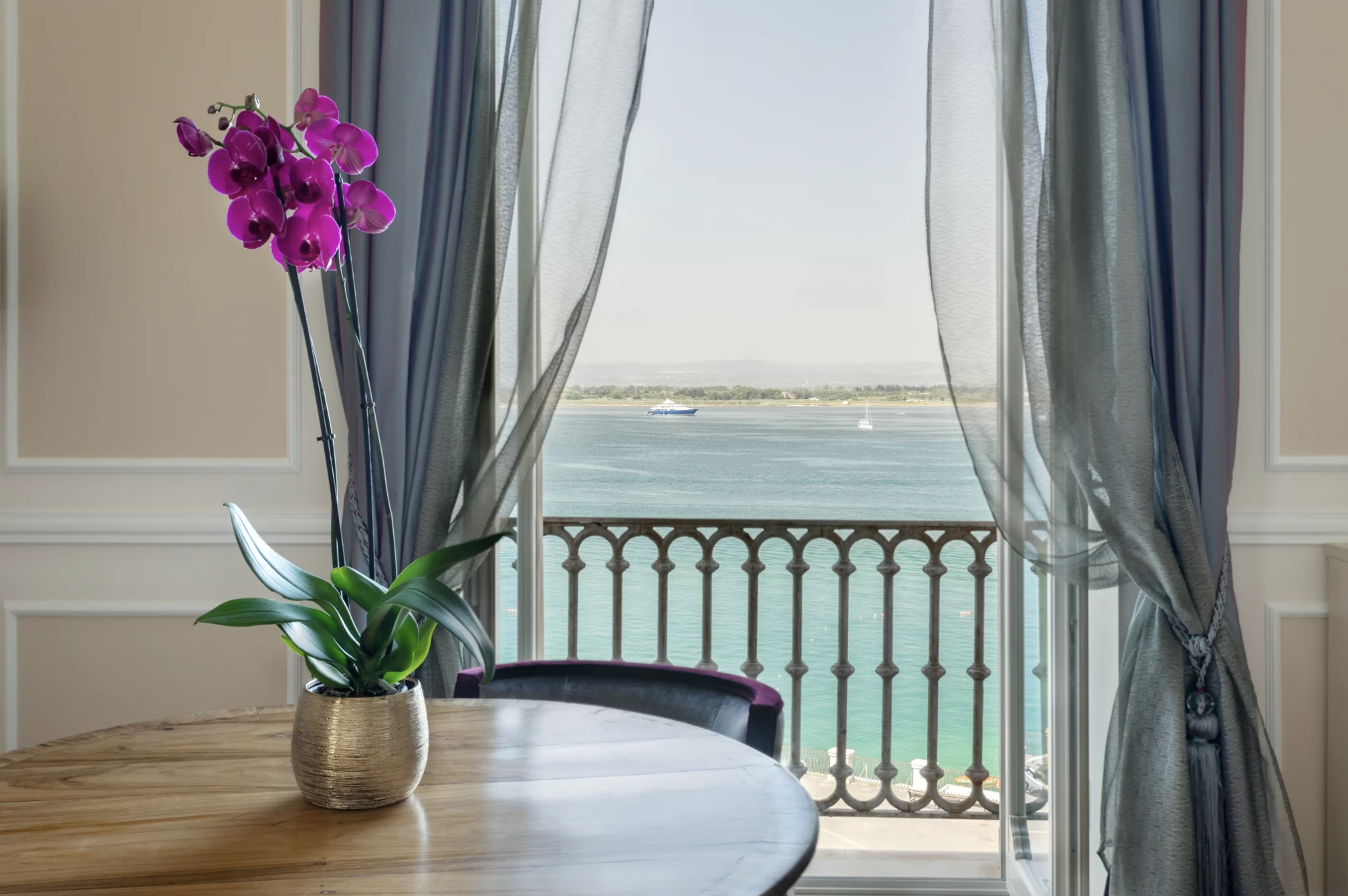
Behind the wheel of the most powerful production car ever
Brutal acceleration is just one facet; it is the ease with which one drives the Bugatti Chiron that makes it different from other supercars.
Related articles
Bugatti has never been shy about breaking rules and raising expectations. That’s why the French marque’s Veyron has, since first emerging from the factory in 2005, been the model by which all other supercars are measured.
Bugatti has been present at Robb Report Car of the Year in 2007, 2010, and 2013. Each time, it has redefined automotive excess—exquisitely. The Veyron Gran Sport was such a stellar achievement that our editors and judges named it the Car of the Decade in 2010. But that decade, like its king, is now dead. Long live the new king, the Bugatti Chiron.

First shown at Geneva in March 2016, the Chiron succeeds the Veyron as Bugatti’s grand statement of what is possible. Possessing 1500hp (1120kW) and an eye-watering window sticker starting at a smidge less than $US3 million, the Chiron deals in numbers that are essentially academic, even for the handful of people who will actually drive — much less own — one. In fact, of the 500 units that Bugatti plans to build, more than half are already spoken for, mostly from buyers of one-or-the-other Veyron variants who have put down substantial deposits to get in line for the mother of all supercars.
We recently attended a small, private showing of the Chiron in Malibu, California, to talk with some of the people responsible for its design and to avail ourselves of the opportunity to drive it. Bugatti Director of Design Achim Anscheidt, who plies his trade at the Volkswagen headquarters in Wolfsburg, Germany, addressed our group with an overview of the Chiron’s design brief. Anscheidt elucidated the solutions he and his team arrived at to satisfy not just aesthetic objectives, but technical challenges encountered in the development of the car.

Engineering a 1500 hp supercar is an exponentially complex project compared to a “mere” 500hp (372kW) vehicle. The volume of air required to feed a quartet of turbochargers while exhausting the heat generated by the Chiron’s 8-litre W16 engine are just two hurdles; making the car civilised is another. We’ve driven many vehicles carrying more than 1000 hp (750kW), and most are a terrifying combination of ill-sorted prototype and wishful thinking. Not so the Bugatti. Despite its 1180 ft lbs of torque (1600Nm) and 420km/h top speed (limited for road use; it’s capable of speeds north of 450km/h), the Chiron is as refined as a Bentley, and docile enough that one’s grandmother could drive it.

Certainly, docile enough for us. Accompanied by Bugatti’s test driver (“Trust, but verify,” I imagine him thinking), we started north of Zuma Beach and drove for miles along Pacific Coast Highway, snicking off onto Kanan Road and arcing south along Mulholland Drive, then backtracking north through Encinal Canyon Road to our point of departure.
Having driven many Veyrons in various guises, we have a pretty good idea of how that model has incrementally improved over its years of production. But the Chiron dials everything up: more power and torque, handling response that is more immediate and light (with less understeer), and seamless shift transitions from the 7-speed DSG dual-clutch gearbox.

The wheels have gotten larger (20-inch and 21-inch in the front and rear, respectively), the tyres are markedly improved and longer lasting, and the brakes are bigger since they have more of a beast to stop in its all-wheel-drive tracks.
While public roads are no place to exploit a car like the Chiron, even a less-than-2.5-second sprint from zero to 100km/h is sufficient to impress the most jaded car person. Acid reflux sufferers will be used to the suffocating sensation — in this case, trying to catch one’s breath as all the air in the universe is sucked up by four greedy turbochargers — while the car catapults forward.

But its brutal acceleration is just one facet of this capable performer’s personality. It is the ease with which one drives this large GT that makes it different from other supercars. No blistering exhaust note, no spine-rattling suspension, no claustrophobic cabin panelled in surgical steel or cold carbon-fibre. Inside, the Chiron is a model of simple luxury, with quilted sport seats and a single shift stalk on a wide centre console. A round analogue instrument (with digital information displayed as needed) and a compact steering wheel punctuate the driver’s view, while a few elegant metal knobs control climate and ancillaries.

And although the Chiron is anything but simple, its designers make it seem so, and that may be the most surprising achievement of all.
It’s hard to imagine a car like this being made today, had not its predecessor been conceived when the year 2000 was looming and Bugatti’s parent company Volkswagen Group was aiming to dominate the supercar world.
They did that with the Bugatti Veyron, and having set the bar, it only makes sense that the Chiron should come around to raise it again.
Subscribe to the Newsletter
Recommended for you
8 Fascinating Facts You Didn’t Know About Aston Martin
The British sports car company is most famous as the vehicle of choice for James Bond, but Aston Martin has an interesting history beyond 007.
May 1, 2024
Rezvani Will Rebuild Your 911 to Go From Zero to 100 in Two Seconds
The shop will build a version of the RR1 based on the Carrera S, GT3, and Turbo S
By Bryan Hood
April 23, 2024
You may also like.
06/05/2024
06/05/2024
30/04/2024
You may also like.
Best fo Europe: Six Senses, Switzerland
Mend in the mountains at Crans-Montana.
Wellness pioneer Six Senses made a name for itself with tranquil, mostly tropical destinations. Now, its first alpine hotel recreates that signature mix of sustainable luxury and innovative spa therapeutics in a world-class ski setting.
The ski-in, ski-out location above the gondola of one of Switzerland’s largest winter sports resorts allows guests to schuss from the top of the Plaine Morte glacier to the hotel’s piste-side lounge, where they can swap ski gear for slippers, then head straight to the spa’s bio-hack recovery area to recharge with compression boots, binaural beats and an herb-spiked mocktail. In summer, the region is a golf and hiking hub.

The vibe offers a contemporary take on chalet style. The 78 rooms and suites are decorated in local larch and oak, and all have terraces or balconies with alpine views over the likes of the Matterhorn and Mont Blanc. With four different saunas, a sensory flotation pod, two pools
and a whimsical relaxation area complete with 15,000 hanging “icicles” and views of a birch forest, the spa at Six Senses Crans-Montana makes après ski an afterthought.
You can even sidestep the cheese-heavy cuisine of this region in favour of hot pots and sushi at the property’s Japanese restaurant, Byakko. Doubles from around $1,205; Sixsenses.com
You may also like.
Best of Europe: Grand Hotel Des Étrangers
Fall for a Baroque beauty in Syracuse, Italy.
Sicily has seen a White Lotus–fuelled surge in bookings for this summer—a pop-culture fillip to fill up its grandes dames hotels. Skip the gawping crowds at the headline-grabbers, though, and opt instead for an insider-ish alternative: the Grand Hotel des Étrangers, which reopened last summer after a gut renovation.
It sits on the seafront on the tiny island of Ortigia in Syracuse, all cobbled streets and grand buildings, like a Baroque time capsule on Sicily’s southeastern coast.
Survey the entire streetscape here from the all-day rooftop bar-restaurant, Clou, where the fusion menu is a shorthand of Sicily’s pan-Mediterranean history; try the spaghetti with bottarga and wild fennel or the sea bass crusted in anchovies. Idle on the terrace alfresco with a snifter of avola, the rum made nearby.

As for the rooms, they’ve been renovated with Art Deco–inflected interiors—think plenty of parquet and marble—but the main asset is their aspect: the best of them have private balconies and a palm tree-fringed view out over the Ionian Sea. Doubles from around $665; desetranger.com
You may also like.
Watch of the Week: TAG Heuer Formula 1 | Kith
The legendary sports watch returns, but with an unexpected twist.
Over the last few years, watch pundits have predicted the return of the eccentric TAG Heuer Formula 1, in some shape or form. It was all but confirmed when TAG Heuer’s heritage director, Nicholas Biebuyck, teased a slew of vintage models on his Instagram account in the aftermath of last year’s Watches & Wonders 2023 in Geneva. And when speaking with Frédéric Arnault at last year’s trade fair, the former CEO asked me directly if the brand were to relaunch its legacy Formula 1 collection, loved by collectors globally, how should they go about it?
My answer to the baited entreaty definitely didn’t mention a collaboration with Ronnie Fieg of Kith, one of the world’s biggest streetwear fashion labels. Still, here we are: the TAG Heuer Formula 1 is officially back and as colourful as ever.
As the watch industry enters its hype era—in recent years, we’ve seen MoonSwatches, Scuba Fifty Fathoms, and John Mayer G-Shocks—the new Formula 1 x Kith collaboration might be the coolest yet.

Here’s the lowdown: overnight, TAG Heuer, together with Kith, took to socials to unveil a special, limited-edition collection of Formula 1 timepieces, inspired by the original collection from the 1980s. There are 10 new watches, all limited, with some designed on a stainless steel bracelet and some on an upgraded rubber strap; both options nod to the originals.
Seven are exclusive to Kith and its global stores (New York, Los Angeles, Miami, Hawaii, Tokyo, Toronto, and Paris, to be specific), and are made in an abundance of colours. Two are exclusive to TAG Heuer; and one is “shared” between TAG Heuer and Kith—this is a highlight of the collection, in our opinion. A faithful play on the original composite quartz watch from 1986, this model, limited to just 1,350 pieces globally, features the classic black bezel with red accents, a stainless steel bracelet, and that creamy eggshell dial, in all of its vintage-inspired glory. There’s no doubt that this particular model will present as pure nostalgia for those old enough to remember when the original TAG Heuer Formula 1 made its debut.

Of course, throughout the collection, Fieg’s design cues are punctuated: the “TAG” is replaced with “Kith,” forming a contentious new brand name for this specific release, as well as Kith’s slogan, “Just Us.”
Collectors and purists alike will appreciate the dedication to the original Formula 1 collection: features like the 35mm Arnite cases—sourced from the original 80s-era supplier—the form hour hand, a triangle with a dot inside at 12 o’clock, indices that alternate every quarter between shields and dots, and a contrasting minuterie, are all welcomed design specs that make this collaboration so great.
Every TAG Heuer Formula 1 | Kith timepiece will be presented in an eye-catching box that complements the fun and colour theme of Formula 1 but drives home the premium status of this collaboration. On that note, at $2,200 a piece, this isn’t exactly an approachable quartz watch but reflects the exclusive nature of Fieg’s Kith brand and the pieces he designs (largely limited-edition).

So, what do we think? It’s important not to understate the significance of the arrival of the TAG Heuer Formula 1 in 1986, in what would prove integral in setting up the brand for success throughout the 90’s—it was the very first watch collection to have “TAG Heuer” branding, after all—but also in helping to establish a new generation of watch consumer. Like Fieg, many millennial enthusiasts will recall their sentimental ties with the Formula 1, often their first timepiece in their horological journey.
This is as faithful of a reissue as we’ll get from TAG Heuer right now, and budding watch fans should be pleased with the result. To TAG Heuer’s credit, a great deal of research has gone into perfecting and replicating this iconic collection’s proportions, materials, and aesthetic for the modern-day consumer. Sure, it would have been nice to see a full lume dial, a distinguishing feature on some of the original pieces—why this wasn’t done is lost on me—and perhaps a more approachable price point, but there’s no doubt these will become an instant hit in the days to come.
—
The TAG Heuer Formula 1 | Kith collection will be available on Friday, May 3rd, exclusively in-store at select TAG Heuer and Kith locations in Miami, and available starting Monday, May 6th, at select TAG Heuer boutiques, all Kith shops, and online at Kith.com. To see the full collection, visit tagheuer.com
You may also like.
30/04/2024
06/05/2024
06/05/2024
8 Fascinating Facts You Didn’t Know About Aston Martin
The British sports car company is most famous as the vehicle of choice for James Bond, but Aston Martin has an interesting history beyond 007.
Aston Martin will forever be associated with James Bond, ever since everyone’s favourite spy took delivery of his signature silver DB5 in the 1964 film Goldfinger. But there’s a lot more to the history of this famed British sports car brand beyond its association with the fictional British Secret Service agent.
Let’s dive into the long and colourful history of Aston Martin.
You may also like.
30/04/2024
06/05/2024
06/05/2024
What Venice’s New Tourist Tax Means for Your Next Trip
The Italian city will now charge visitors an entry fee during peak season.
Visiting the Floating City just got a bit more expensive.
Venice is officially the first metropolis in the world to start implementing a day-trip fee in an effort to help the Italian hot spot combat overtourism during peak season, The Associated Press reported. The new program, which went into effect, requires travellers to cough up roughly €5 (about $AUD8.50) per person before they can explore the city’s canals and historic sites. Back in January, Venice also announced that starting in June, it would cap the size of tourist groups to 25 people and prohibit loudspeakers in the city centre and the islands of Murano, Burano, and Torcello.
“We need to find a new balance between the tourists and residents,’ Simone Venturini, the city’s top tourism official, told AP News. “We need to safeguard the spaces of the residents, of course, and we need to discourage the arrival of day-trippers on some particular days.”
During this trial phase, the fee only applies to the 29 days deemed the busiest—between April 25 and July 14—and tickets will remain valid from 8:30 am to 4 pm. Visitors under 14 years of age will be allowed in free of charge in addition to guests with hotel reservations. However, the latter must apply online beforehand to request an exemption. Day-trippers can also pre-pay for tickets online via the city’s official tourism site or snap them up in person at the Santa Lucia train station.
“With courage and great humility, we are introducing this system because we want to give a future to Venice and leave this heritage of humanity to future generations,” Venice Mayor Luigi Brugnaro said in a statement on X (formerly known as Twitter) regarding the city’s much-talked-about entry fee.
Despite the mayor’s backing, it’s apparent that residents weren’t totally pleased with the program. The regulation led to protests and riots outside of the train station, The Independent reported. “We are against this measure because it will do nothing to stop overtourism,” resident Cristina Romieri told the outlet. “Moreover, it is such a complex regulation with so many exceptions that it will also be difficult to enforce it.”
While Venice is the first city to carry out the new day-tripper fee, several other European locales have introduced or raised tourist taxes to fend off large crowds and boost the local economy. Most recently, Barcelona increased its city-wide tourist tax. Similarly, you’ll have to pay an extra “climate crisis resilience” tax if you plan on visiting Greece that will fund the country’s disaster recovery projects.
























